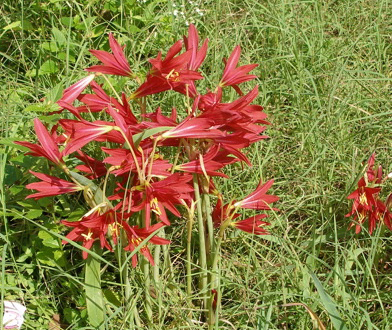Human Flower Project
Friday, September 07, 2007
School House Lilies
On schedule, students are back in class and the school house lilies are in bloom. Jill Nokes, author of the forthcoming book Yard Art & Handmade Places, notes the paradox of their simultaneous uprooting and rediscovery. Thank you, Jill!

Homer comes upon a display of oxblood lilies
in an abandoned yard in Hyde Park, Austin, TX
Photo: Jill Nokes
By Jill Nokes
A developer is tearing down four houses across the street from our neighborhood park. No doubt the lots will soon be packed with houses built super-sized to exploit the high value of central city land. I won’t be missing the houses so much; they weren’t anything special, just simple wood-frame cottages built after WW II, with refreshingly modest proportions. But what I will miss are the masses of school house lilies that would suddenly appear in the neglected yards of those shabby rent houses in late August and September, after the first rains came to break summer’s long drought. Every year, among the dried pecan husks, sticker-burrs, and overgrown Bermuda grass, the bulbs would seem to emerge overnight; a sure signal that summer was beginning to wind down and the most delightful of Texas seasons- fall – was around the corner. It always felt like Mother Nature was signaling us to hold on just a little bit longer.
“School house lily” is just one of the names given to this bulb, Rhodophiala bifida. It was assigned, no doubt, because these little amaryllids appear right around the time school starts. A more familiar name for them is “oxblood lilies.” Their bright red, delicate blossoms are held on smooth, slender stems and form random bouquets across the yard. Sometimes in old yards you can tell where the owner might have lined a walkway with them. They multiply quickly from offsets, sprinkling themselves around the yard in ways never intended by the original owner, but still a delight to the passerby.

Rhodophiala bifida, fall harbinger in Central Texas
Photo: Jill Nokes
Scott Ogden, in his book Garden Bulbs for the South, tells us that these lilies are natives of Argentina and Uruguay. “No other Southern bulb can match the fierce vigor, tenacity, and adaptability of the oxblood lily,” writes Ogden. “Whether planted on worn-out gumbo clay, or on impoverished sand, the long-necked black bulbs make themselves at home. The plants send out thick, white roots, which contract and pull them deeply into the soil, sometimes as far as eighteen inches. Safely hidden in the cool earth, they multiply into healthy clumps.”
Central Texas is a good place to find these forgotten colonies of scarlet bulbs, for it was a German émigré, Peter Henry Oberwetter, who imported the bulbs while living in Austin until his death in 1915. As Ogden remarks, “he must have discovered and selected the vigorous Rhodophiala strain we now enjoy.”
Oxblood lilies are making a come back in the horticultural trade. You can buy them on line and many nurseries have baskets of the bulbs for sale in spring. Still, I will miss their random, extravagant displays in untended and forgotten yards.




